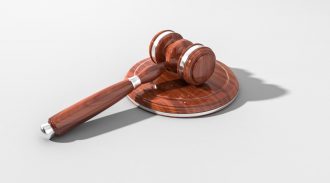August 17, 2021
Wayback Machine Helps Prove Exhibit was Prior Art
In Valve Corporation v. Ironburg Inventions Ltd., [2020-1315, 2020-1316, 2020-1379] (August 17, 2021), the Federal Circuit affirmed in part, reversed in part, vacated in part, and remanded two PTAB decisions determining that some claims of U.S. Patent No. 9,289,688 were shown to be unpatentable, while other claims of the ‘688 patent and the claims of U.S. Patent No. 9,352,229 were not shown to be unpatentable.
The ’688 patent is directed to an improved controller for a games console that is intended to be held by a user in both hands in the same manner as a conventional controller that comprises additional controls located on the rear of the controller. The ’229 patent is directed to a handheld controller for a games console, wherein the controller further includes at least one additional control located on a back of the controller.
An issue in both of the appeals is whether an Exhibit to the petition relied on by Valve was shown to be a printed publication and thus prior art under 35 U.S.C. § 102(a)(1). Valve asserted that the Exhibit was a printed copy of an online review of an Xbox 360 controller published on October 20, 2010. Valve argued that the Exhibit was prior art because it was a printout of the same online article by Dave Burn that was cited and enclosed in the prosecution histories of the ’688 patent and ’229 patent.
The Board rejected Valve’s showing on the ground that the Exhibit had not been shown to be the same as the asserted prior art documents in the prosecution histories. This is essentially a determination that Valve failed to prove that the Exhibit was what Valve what claimed it to be, which is an issue of authentication. See Fed. R. Evid. 901(a) (“To satisfy the requirement of authenticating or identifying an item of evidence, the proponent must produce evidence sufficient to support a finding that the item is what the proponent claims it is.”).
The Federal Circuit noted that the Exhibit could be authenticated by a comparison with an authenticated specimen by an expert witness or the trier of fact, and that such authentication by comparison is routine, and that the Board had an obligation to make such a comparison. The Federal Circuit concluded that the Exhibit is substantively the same as articles in the prosecution histories.
The Federal Circuit further rejected the argument that the Exhibit has been shown to be publicly accessible before the priority date. The Federal Circuit said that there was overwhelming evidence that the article in another of Ironburg’s patents was prior art, and thus the Exhibit, which is substantively the same, is also prior art. There was testimony from one of the co-inventors, that he provided information to the author of the article for promotional purposes.
The timing of the publication of the article was confirmed by the patent examiner via the Wayback Machine, which the Federal Circuit found was highly persuasive evidence of public accessibility. The Federal Circuit also noted that the inventors did not dispute the publication date of the article when it was cited against them during prosecution. Finally, the Federal Circuit found that the fact that Examiner found the reference after a “brief” search was highly probative evidence of public accessibility.
The Federal Circuit reversed and remanded for consideration that the Exhibit was in fact prior art.
Valve also appealed the Board’s determination that Valve failed to prove that claim 29 of the ‘688 patent and claims 1-15 and 18-24 of the ‘229 patent were unpatentable. The claims required an elongate member that “is inherently resilient and flexible.” The reference showed a member that was resiliently biased with a spring. The Board found that the spring was not part of the elongate member, and the Federal Circuit found no error in this determination.
Ironburg appealed the determination that claims of the ‘688 patent were anticipated, arguing two limitations:
- “a first surface disposed proximate an outer surface of the case,” and
- “a second surface opposing the first surface”
Under the ordinary meaning of these terms, the Federal Circuit found a “first surface disposed proximate an outer surface of the case” requires that the first surface of the additional control and the outer surface of the case be arranged close or near to each other, but does not require them to be facing each other, rejecting Ironburg’s construction.
As to the “opposing” limitation, the Federal Circuit agreed with the Board’s construction that the “opposing” limitation is met by two surfaces that face each other or are opposite each other, and that this did not require that the surface be flat as contended by Ironburg.




































